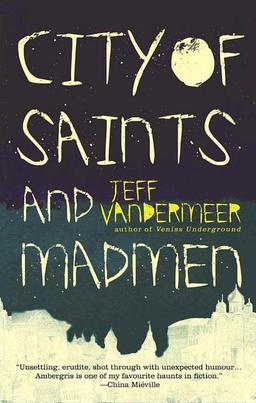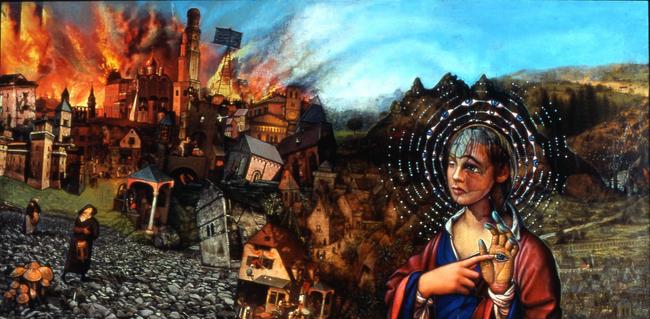An Intoxicating Blend of Steampunk and Gothic: Jeff Vandermeer’s City of Saints and Madmen
 There I was, quite happily dawdling through life, free of all unhealthy obsessions, more or less content, sleeping, eating, breathing and only occasionally contemplating suicide all without a care in the world. How can I, innocent young boy that I am, be blamed for not knowing what I was getting into when I saw City of Saints and Madmen languishing on the shelf of my local Waterstones, its nondescript, faintly pretentious cover standing out as slightly less nondescript and slightly more pretentious then all the book covers, how can I be blamed if, eager to seem like the haughty intellectual I think I am, I picked it up, plopped it on the counter and handed over the criminal £10.99? I was ignorant, I was foolish, I was young and naive and romantic. I was just trying something new, buying something on impulse because, let’s face it, my life is nothing if not a series of impulse purchases and suppressed subconscious truths like ‘Connor, maybe you shouldn’t jam that entire screwdriver down your throat.’ Don’t get me wrong, though, I don’t regret buying City of Saints And Madmen — it’s the big dog’s biscuit — it’s just that it’s too good; I’m a busy guy, you know? All this saving the world from the Neo-Nazis on the moon and wrestling bears and kissing pretty girls (right on the lips, too!) is pretty time consuming stuff — I just don’t have the time to sit and grow increasingly obsessed with ridiculously good books like this. It’s just not feasible. But I did, anyway. And I loved it.
There I was, quite happily dawdling through life, free of all unhealthy obsessions, more or less content, sleeping, eating, breathing and only occasionally contemplating suicide all without a care in the world. How can I, innocent young boy that I am, be blamed for not knowing what I was getting into when I saw City of Saints and Madmen languishing on the shelf of my local Waterstones, its nondescript, faintly pretentious cover standing out as slightly less nondescript and slightly more pretentious then all the book covers, how can I be blamed if, eager to seem like the haughty intellectual I think I am, I picked it up, plopped it on the counter and handed over the criminal £10.99? I was ignorant, I was foolish, I was young and naive and romantic. I was just trying something new, buying something on impulse because, let’s face it, my life is nothing if not a series of impulse purchases and suppressed subconscious truths like ‘Connor, maybe you shouldn’t jam that entire screwdriver down your throat.’ Don’t get me wrong, though, I don’t regret buying City of Saints And Madmen — it’s the big dog’s biscuit — it’s just that it’s too good; I’m a busy guy, you know? All this saving the world from the Neo-Nazis on the moon and wrestling bears and kissing pretty girls (right on the lips, too!) is pretty time consuming stuff — I just don’t have the time to sit and grow increasingly obsessed with ridiculously good books like this. It’s just not feasible. But I did, anyway. And I loved it.
How could you blame me, though? This book is beautiful. It’s this intoxicating blend of steampunk and gothic, the twisted and the strange, its equal parts romantic and surreal, decadent and utopic and as cynical as it is intangibly hopeful; it’s written with such indefatigable passion and energy that you can feel it sparking off the page, spilling out, breathlessly, into the room around you. It’s in the thick miasma of Vandermeer’s wonderful prose, the breathless detail of his lurid settings, the unrelenting weird of his twisted narrative. There are so many reasons you should read this book I don’t know quite where to start — it’s this huge, sprawling intimidating thing that excites on so many levels explaining it is like describing the Coliseum to a man with no eyes, and only the basest knowledge of human history.
I guess maybe I should start at the beginning, by actually doing my job and telling you what it is I’m rambling on about. City of Saints and Madmen is what people more intelligent than myself have termed ‘A mosaic novel’, that is to say a novel of separate stories that link together thematically, and have a few recurring characters and the same setting and stuff. The first four, and arguably most important, of these are “Dradin, In Love,” wherein a missionary returns from the jungle and falls in love with a woman in a shop window; “The Transformation of Martin Lake,” where an artist receives a strange invitation to a masquerade at an obscure address at a time of immense, but actually decipherable, political strife; “The Early History Of Ambergris,” an essay published as though Ambergris (the setting of the book) wasn’t actually a land of make believe and wonder which I’m not going to explain because most of you aren’t idiots; and the “Strange Case of X,” wherein a stonking great author surrogate is convinced he’s in the (supposedly fictional) city of Ambergris and winds up in a psychiatric hospital for some intense questioning and a bout of immense self-congratulation. There’s also a load of other stuff that I’ll mention when it’s relevant, because I didn’t read this book twice to write 500 words of plot synopsis — I did it to write 2,000 words of melodramatic rambling.

That said, however, reading City of Saints and Madmen twice is almost mandatory if you’re going to stand any chance of actually understanding it, and that’s cover to cover, too, none of that skipping chapters lark — you’ve got to go from cover to cover like the good little school boy (or girl) you are. That’s because, when you first read it, City of Saints and Madmen will confuse you — it dives head first into the stygian beauty of its setting before you’re given any chance to understand what a ‘mushroom dweller’ is or where to find ‘Alboumuth Boulevard’ or who ‘Hoegbottom and Sons’ are or why everyone’s naked and murdering each other all of a sudden; events in some stories will seem strange, random, out of the blue, but aren’t explained until later in the book — there are essays about art that doesn’t exist and a type of squid that isn’t real, and for a drooling idiot like me, or for the kind of person who just doesn’t have the time to dive, headlong, into a strange fictional world with no worries about silly things like the real world and eating, it’s all a bit much.
But you’re going to want to dive headlong into the strange fictional world of Ambergris. For a lot of reasons, like, because I told you to, and, because you want to escape the depressing reality of your own existence, and also because it’s really, really good.
The city is fully realized and utterly unique, strange enough to be memorable and haunting, but real enough, palpable enough for you to start seeing shades of it everywhere you go, in the docks and marinas of wherever it is you live, in darkened alleys and shadowy underpasses — it’s reflected everywhere at once, and yet never quite mimicked. It might be a cliché to say Ambergris is as much a character as any of the protagonist, but it is, and it’s the most interesting one of the lot.
A lot of that feeling is probably down to the cities duality; outlined in the title itself, it’s very much evident that Vandermeer understands that no real city is perfect, that beautiful, enlightened utopias free of crime and bigotry and social inequality simply do not exist and that, by the same token, cityscapes that are instead nightmares, where every corner hides a football hooligan with a big stick or a welder with huge muscles and a seething hatred for tourists don’t exist either; all cities are merely a mix of the two. Ambergris takes this theory to its next logical extreme, it’s utterly lawless, the only thing it has approaching a leader being the corporate mega giant Hoegbotton and Sons, or the ever enigmatic playwright Voss Bender, and even these figures can only ever manipulate, twist and adjust and influence, they can make minute alterations to the path the city is heading down, but they can never, really, truly, make a change that Ambergris itself does not agree with — as such the city is rife with crime, with murder, thievery, double crossings, slavery, and human trafficking; anything you can think of is most probably happening in your peripheries at any given time. Here, walking down the road without a map can see you lost in the cities labyrinthine embrace, taking a corner without thinking about it can get you murdered by a giant and freakishly intelligent mushroom man.
And yet, at the same time, the city is capable of startling beauty — it’s this utopia for artists and writers and composers, it brims with this sullen, gothic architecture, with art that’s both decadent and macabre; every inch of it brims with esoteric and melancholic delights, it’s at once beautiful and horrifying, fleshed out and mysterious, and one gets the sense that every tale told within its walls is just one of a thousand others milling about and bashing elbows together. Ambergris might only exist on the pages of a book, but it succeeds, utterly, in terms of exciting all of one’s senses. It really does take that old primary school mantra of ‘what does he see, smell, hear and feel?’ to heart.
That’s got a lot to do with Vandermeer’s prose. It might be read as slightly over done, as a bit purple, as overwritten, but, for me at least, it so perfectly suits the cluttered, bustling nature of the city, the myriad wonders and multi-colored horrors it describes — a lone girl and a record player sat, listening to music, amongst her hanged and murdered family, a graveyard for rusting steam trains and corpses alike, hordes and hordes of empty houses — deserted exactly as their owners (all of whom mysteriously disappeared) left them. Vandermeers prose drips with a genuine passion, a real, palpable love for just the act of writing, and it’s got quite a range, too. There’s an immense amount of variety in City of Saints and Madmen, such that every novella and short story has its own unique voice and character — you couldn’t mistake “Dradin, In Love” for “The Transformation of Martin Lake,” for example — even if you restricted yourself to a sentence. If any of you remember that post I did about the difference good prose can make, “Who Took the Flowers Out of my Prose?,” this is a pretty good working example.
And it’s all done with such a sense of humor. City of Saints and Madmen might be darkly surrealist, a kind of harrowing, especially vivid fever dream, but it’s one that’s seasoned, periodically, with a wonderful sense of humor — something somewhere between slapstick, utterly filthy and gallows. There’s an entire section of a major religion dedicated to crapping, peeing, farting and ejaculating on things, the author of an essay on the city’s early history constantly derides his readers and other historians, and there’s a series of books wherein a gang of anthropomorphic squids make what is essentially the pope admit sodomy. Crucially, though, Vandermeer never once blinks an eye or tells his reader, ‘Oh look, isn’t this funny!? Let’s all laugh at the very funny thing!’
For all its frequent absurdity, the book is never self-referential — which means it is never laughing so hard and so loud at itself you can’t actually laugh along with it, if you know what I mean. And it achieves all this without ever sacrificing its sense of atmosphere or tone.
And for all the strange and enchanting delights of this book, its characters never once feel far-fetched or false, they always feel human, they could be madmen recovering from jungle fever and PTSD, tortured artists, or an apathetic businessman trying to fend off the competition and secure his next deal. They could have pasts as colorful and as haunting as Ambergris itself (and many of them do) but they always feel real, flawed, human. It might seem strange of Dradin from “Dradin, in Love” to fall in love with a woman he sees once in a shop window, but it’s something we all do, in a sense; the woman is a blank slate on which Dradin can project his ideals and his fantasies, and it’s these fantasies he falls in love with, not the woman herself (although, it does kind of help that Dradin’s just a little bit mental). Martin Lake from “The Transformation of Martin Lake” might look like your archetypal tortured, aloof artist on the outside, but look deeper and you’ll see he’s just playing to a stereotype for effect — there’s self-awareness there, a degree of guilt, of regret, and a wry wit that’s a joy to read. Even the aforementioned essay on the history of Ambergris has its own character, the historian who writes it, who is somewhere between arrogant and self-deprecating, and it’s brimming with discrepancies and sources that may or may not be reliable, as well as theories about those sources. You know, just like real historical essays.
 It’s not until after the fourth work, “The Strange Case of X” (which got a bit self-congratulatory at times, even if it retained a certain sense of poignancy), that I felt things started to drop the ball a bit — a lot of the short stories from this point on start to become strange simply for the sake of being strange, which is fine, but it means these later works are less faceted, not as deep as the earlier ones, a lot less coherent and a lot more pretentious; they’re still somber and sad, still haunting and surreal; they’re still very, very good, and there are still a few standouts (“In The Hours After Death,” in particular), they’re just not as good as those first four works. There’s an also an essay on this thing called the king squid which has to be mentioned solely because of how bloody boring it is. I know calling something boring makes me sound like a spoiled ten year old, but it is — it’s just a dude talking about squids for a hundred odd pages. It’s not even all that relevant, really; the early history of Ambergris piece at least had the luxury of offering some stories of its own, but the king squid, although undoubtedly central to the culture of the city, has only really been tangential to the stories we’ve been told as a reader — it has so little to do with the characters or narratives we care about (with a few exceptions aside) it’s jarring.
It’s not until after the fourth work, “The Strange Case of X” (which got a bit self-congratulatory at times, even if it retained a certain sense of poignancy), that I felt things started to drop the ball a bit — a lot of the short stories from this point on start to become strange simply for the sake of being strange, which is fine, but it means these later works are less faceted, not as deep as the earlier ones, a lot less coherent and a lot more pretentious; they’re still somber and sad, still haunting and surreal; they’re still very, very good, and there are still a few standouts (“In The Hours After Death,” in particular), they’re just not as good as those first four works. There’s an also an essay on this thing called the king squid which has to be mentioned solely because of how bloody boring it is. I know calling something boring makes me sound like a spoiled ten year old, but it is — it’s just a dude talking about squids for a hundred odd pages. It’s not even all that relevant, really; the early history of Ambergris piece at least had the luxury of offering some stories of its own, but the king squid, although undoubtedly central to the culture of the city, has only really been tangential to the stories we’ve been told as a reader — it has so little to do with the characters or narratives we care about (with a few exceptions aside) it’s jarring.
And the short stories take a bit of a dive, as well, becoming strange just for the sake of it, losing the focus of the earlier works. It reaches the point where two of the short stories, “Learning to Leave the Flesh” and “The Cage,” don’t even have proper endings. (Spoilers here, although I’ve tried my best to avoid them so far.) They both end with the characters taking something’s hand and walking off into the sunset. They’re are utterly devoid of closure, of significance, or of any real meaning — they’re something a pubescent English student would do, one who wants to make some grand, sweeping statement about the fleeting nature of life but isn’t really sure how.
Or maybe there is some sort of a message in there that I’m too proletariat to get, I don’t know, but can you blame me if I get irritated when characters and conflicts I’ve been introduced to and attached to, are left, suspended in mid-air, nothing solved or resolved or changed, never to be picked up again?
The thing is, “The Cage,” at least, was a very good story, one of the few works of fiction to ever make me brick myself in and sit cowering under my bedsheets with a high caliber sniper rifle all night. It had human characters, a genuine sense of mystery, a sullen hallucinatory feel to it, touches of Edgar Allen Poe mingling with those of Mervyn Peake — it was really really really lovely, is what I’m saying — but it’s ending, it’s frustrating lackluster ending, let it down.
Ultimately though, City of Saints And Madmen is just a little bit brilliant — it’s as funny as it is terrifying as strange as it is sad — it’s beautiful and dark and fully realized. It’s this huge swirling pot of Moorcock and Poe and Peake and something entirely Vandermeers own, and it’s a joy to jump into and devour, despite its ups and downs. Ambergris is probably one of the deepest and least predictable settings I’ve had the pleasure of exploring.
Oh! And before you toddle off on your way, rather than sitting around not writing for the past few months, I’ve actually started my own site! Isn’t lovely?
It’s called Digging for Stupid and its right here.
It’s still pretty new, and its details are prone to change as I gradually learn new stuff, but there’s content on there, and I’m hoping to make more of it. It’ll be of a different nature to what I do on Black Gate, and it’ll focus more on video games and comedy. So, I don’t know, if you’ve enjoyed my video game stuff before, and if you like my sense of humor, maybe give it a little look.

I didn’t read this book twice to write 500 words of plot synopsis — I did it to write 2,000 words of melodramatic rambling.
This could totally be my motto as a book reviewer.
Hehe, maybe we should start our own T-shirt line or something, really start reeling in the big bucks ;).
Although, in all honesty, melodramatic rambling is the best part of reviewing a book
There could totally be a Black Gate T-shirt line. Sooner or later, John will sell off the last collectible back issues of the paper magazine, and then how will the web-hosting bills be covered?
> sooner or later, John will sell off the last collectible back issues of the paper magazine, and then how will the web-hosting bills be covered?
I haven’t even dipped into the pulp collection yet. That should last us through 2012.
Pulp collection- schmulp collection- everyone knows internet bloggers are a the fore front of Fashion we shouldn’t let our talents wither and die by not designing our own T-shirt line. Besides, we could fill them up with obscure references that only Black Gate readers will get, and then we’re only a few steps away from starting a fully fledged cult, which, if I’m not mistaken, was the original idea 😉
I thought the cult idea was already taken.
Originally it was, yeah, but the group of fifteen year olds ort of gave it up when ythey found out how hard it is to find goats in the inner city, and that its a little bit illegal to sacrifice (to the gods of fantasy fiction!) in the middle of the street